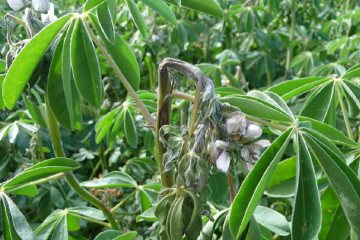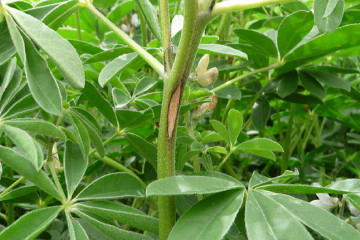Australian Pulse Bulletin
Lupin fungicide guide: 2020 season
Lupins are affected by several serious foliar fungus diseases including Lupin anthracnose (LA) and Sclerotinia stem rot (SSR). Others including Brown spot (Pleiochaeta setosa) and Phomopsis stem blight (Diaporthe toxica) are best managed by rotating paddocks to non-host crops, using resistant varieties or fungicide seed dressings and rarely cause economic damage.
Lupin anthracnose is a serious fungal disease that is found in several regions around Australia. Most recently an outbreak of the disease occurred in southern NSW in 2016, but the disease has been endemic in WA and SA since 1996.
Surveillance programs by NSW DPI Biosecurity and LLS in 2017-18 across NSW showed no signs of the disease re-developing and the restrictions have now been lifted to allow lupins to be grown across all areas.
Vigilant monitoring of lupin crops still needs to be carried out for this disease, and the five-point plan developed by NSW DPI to prevent establishment of the disease in NSW (link attached) is strongly recommended for NSW producers.
( http://www.dpi.nsw.gov.au/biosecurity/plant/recent-pest-arrivals/lupin-anthracnose)
Pulse Australia have Minor Use Permits from APVMA to help growers manage LA and SSR disease in lupin crops in some states, and these are shown in the table below along with all the currently registered products.
Decisions need to be made such as when to start the spray program and how often to spray, depending on the varietal resistance, the prevailing weather conditions and the potential yield of the crop.
Fungal disease control is based on protection of crops rather than curing existing outbreaks. The first fungicide application must be applied as early as necessary to minimise the establishment of the disease. Additional applications are required if the weather conditions favour disease establishment.
Fungicides remain effective for approximately 10-14 days, but keep in mind that all new growth after application is unprotected.
The need for repeated fungicide application depends on the amount of unprotected growth, the amount of rainfall since spraying and the likelihood of a further extended wet period.
Seasonal Conditions in 2020
Seasonal conditions have changed markedly in 2020 compared to the last few seasons, especially in the eastern states. After a hot and dry summer in many regions, with bush fires threatening many farming communities, early February and March saw widespread rain events across much of the eastern states coming from north west cloud bands. NSW and Victoria were well above average for this period and meant that dry soils were all recharged ready for the winter cropping seasons. Follow up rain has got the season off to an excellent start. Qld also received reasonable falls in February, but many areas have not had decent follow up falls, so crops are struggling at present. South Australia has had some reasonable rainfall, the south eastern areas were too wet and crop planting was delayed. Overall through SA has crops off to a good start. In Western Australia the southern and eastern grain belts have again had a dry start, similar to 2019, but recent rainfall has improved prospects.
These conditions have meant that diseases need to be monitored closely in many regions, particularly in the eastern states. Monitoring needs to be continued through the different growth stages of the crop. With good access for ground sprayers this year, allowing for high water rates and canopy penetration, timely fungicide application will give the crop the best chance of a high yield.
For more detailed information on disease management:
- Lupin best management guide
- CropPro lupin disease manual
- Fungicide resistance in grain crops (including pulses)
Minor Use Permits for fungicide on lupins
- PER82209 Chlorothalonil / Albus lupin / Anthracnose / Current to 30-Nov-2021 (NSW and WA)
- PER82240 Boscalid / Narrow-Leaf Lupins & Albus Lupins / Sclerotinia Stem Rot (White Mould) / Current to 30-Sep-2020 (WA only)
- PER82261 Iprodione / Narrow-Leaf Lupins & Albus Lupins / Sclerotinia Stem Rot (White Mould) / Current to 30-Sep-2020 (WA only)
Fungicides registered for disease control in lupins
| Lupin Foliar Fungicide
|
Trade Name example
|
Anthracnose
|
Botrytis grey mould
|
Sclerotinia
|
WHP Harvest
|
|---|---|---|---|---|---|
| Chlorothalonil
|
Bravo 500
|
Permit 2.0 L/ha
|
NR
|
NR
|
14 days
|
|
|
Bravo 720
|
Permit 1.5 L/ha
|
NR
|
NR
|
14 days
|
|
|
Mueso 900
|
Permit 1.1 L/ha
|
NR
|
NR
|
14 days
|
| Mancozeb 750
|
Dithane DF
|
1.0 to 2.2 kg/ha
|
1.0 to 2.2 kg/ha
|
NR
|
28 days
|
| Boscalid 500
|
Filan
|
NR
|
NR
|
Permit 0.4 to 1.0 kg/ha (WA only)
|
21 days
|
| Iprodione 500
|
Rovral
|
NR
|
NR
|
Permit 1.0 to 1.5 L/ha (WA only)
|
49 days
|
| Iprodione 250
|
Titan
|
NR
|
NR
|
Permit 2.0 to 3.0 L/ha (WA only)
|
49 days
|
| Tebuconazole + Azoxystrobin
|
Veritas
|
NR
|
0.75 to 1.0 L/ha
|
NR
|
28 days
|
Many of the Minor Use Permits have short term expiry dates (e.g. 30/11/2017)
NR = Not Registered
Read the LabelAs with any chemical application, care should be taken to observe all the label conditions for each product. Some label advice is different for each state or region, so for best results, it is important that this is followed. Many of our pulse crops are exported for human consumption, so market access is dependent on having the product free of chemical residues. Australian has a reputation for providing clean and safe produce so it is vital that this is maintained by using chemicals according to regulations. All permits have label recommendations for use rate and withholding periods (WHP) that must be observed so grain will comply with Maximum Residue Limits (MRL) allowable for market access. |
Key contacts
Pulse Australia Industry Development Managers
- Paul McIntosh
Phone: 0429 566 198 - Phil Bowden
Phone: 0427 201 946
Support and funding acknowledgement
Disclaimer
Information provided in this guide was correct at the time of the date shown below. No responsibility is accepted by Pulse Australia for any commercial outcomes from the use of information contained in this guide.
The information herein has been obtained from sources considered reliable but its accuracy and completeness cannot be guaranteed. No liability or responsibility is accepted for any errors or for any negligence, omissions in the contents, default or lack of care for any loss or damage whatsoever that may arise from actions based on any material contained in this publication.
Readers who act on this information do so at their own risk.
Copyright © 2015 Pulse Australia
All rights reserved. The information provided in the publication may not be reproduced in part or in full, in any form whatsoever, without the prior written consent of Pulse Australia. www.pulseaus.com.au
Last updated: 13 August 2020



